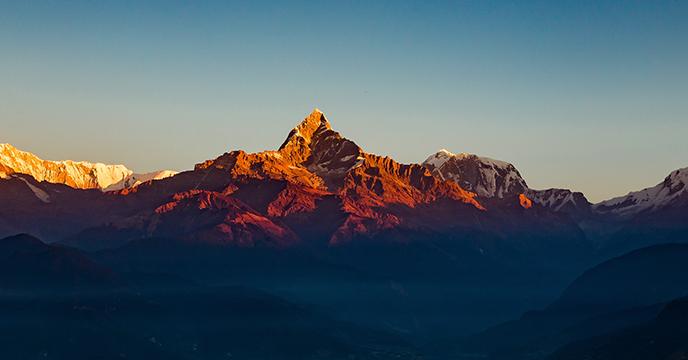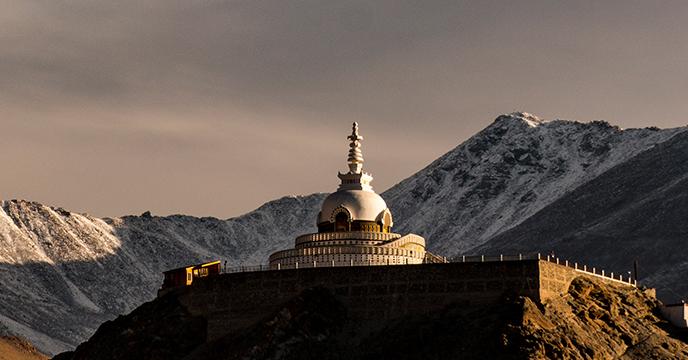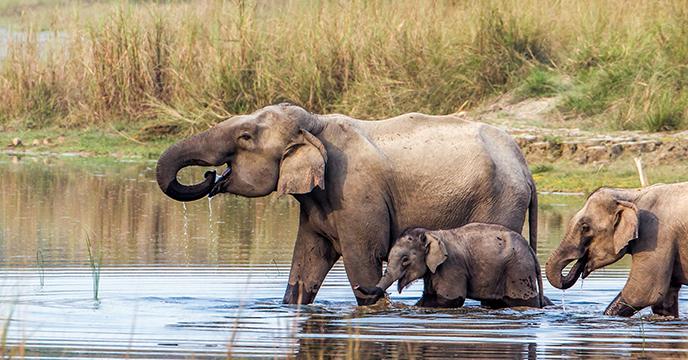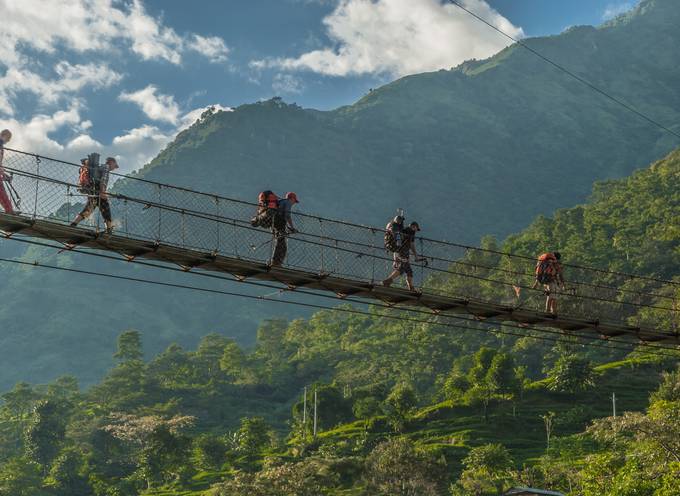
Nepal Travel Guide
If there was ever a place as close to Shangri-La as you could get on Earth, it’s Nepal. With ts prayer flags quietly dancing in the wind or its towering, snow-capped peaks that dominate its skylines, Nepal has an ethereal, untroubled way that steers you to an astral vibe that is truly mesmerising. Nepal is full of enchantments waiting to be explored.
The Highlights


The Basics
The Location
A country in southern Asia in the Himalayas, Nepal borders China, India and Bangladesh. It’s a 19-hour flight from New York with a layover. From London, it’s about 12 hours, also with a stopover.
Capital City
Kathmandu is situated in the Kathmandu Valley in central Nepal. It’s the largest city in Nepal and best known for its old town and as the gateway to the country’s best attractions.
Main Airport
Kathmandu's Tribhuvan International Airport is the main hub for international travellers. It is located in Kathmandu, 5.5 kilometres from the popular neighbourhood of Thamel.
- Code
- KTM
- Closest City
- Kathmandu
Language Spoken
The official language of Nepal is Nepali. As English is the language of commerce, it is widely spoken, especially among educated Nepali. Note that many speak a unique dialect called Nenglish or Nepali English.
Currency
Nepal uses the Nepalese Rupee. The currency code is NPR. Make sure to bring traveller's cheques and some cash, as ATMs can be unreliable or limited to local banks especially outside Kathmandu and Pokhara. Be aware of power failures when using ATMs.
Visas
For most citizens travelling to Nepal, a visa is issued upon arrival for 15, 30 or 90-day stays. Be aware that you will be limited to 150 days for each 12 month period as a tourist. Volunteering on a tourist visa is strictly prohibited.
Electricity
The electrical current in Nepal is 220V/50hz using either the three round prongs, small or big, as well as two round prongs.
Vaccinations
Boosters for Diphtheria, Hepatitis A, Tetanus and Typhoid are advised. Other recommended vaccinations are Japanese Encephalitis, Rabies, Cholera and Hepatitis B. Consult your doctor 4 to 6 weeks before you depart.
Emergency Calls
The phone numbers to call in case of emergency are 100 for the police, 102 for an ambulance and 101 for a fire.
When to Visit

Nepal Tours

Visit Responsibly
Travelling responsibly means respecting the communities, culture and environment of the places you visit. Keep these tips in mind when travelling to Nepal:
Go green. Be environmentally conscious on the road by taking short showers; turning off the lights in your hotel room when you leave; and resisting the urge to collect any plants, seashells, or other natural flora.
Respect cultural differences. Before travelling, read about the local culture and customs – even just knowing the dress code and a few basic phrases in the local language will go a long way.
Support local businesses. Enjoy a more authentic experience and directly support the local economy by travelling with a local guide, eating in local restaurants, buying from local artisans, and staying in locally-owned and operated accommodations.
Wherever possible, avoid single-use plastics. Pack reusable items such as your own shopping bags, utensils, a water bottle, and a straw. These items are typically lightweight and compact, and will greatly reduce your consumption of plastics.
Be conscious of overtourism. Opt to visit the lesser-known regions of Nepal or travel outside the peak season – you'll likely even get a better deal and won't have all the crowds!Sustainable Tourism in Nepal
National Parks and Wildlife Conservation Act of 1973
Nepal made conservation and protection of the natural environment a priority in the early 1970s. The nature conservation act covers the popularly visited Annapurna region, UNESCO sites like the Chitwan National Park and Sagarmatha National Park, and the Gauri Shankar conservation area.
Using Tourism to Alleviate Poverty in Nepal
In 2007, Nepal launched the Tourism for Rural Poverty Alleviation Programme (TRPAP). This program was designed to use tourism to help address disadvantaged groups by focusing on human resource issues, sustainable tourism planning, and collaboration between the local private and public sectors. When assessing the effectiveness of the program, it has been noted that the project improved infrastructure in select rural areas, thousands of people received skills training for tourism, and there has been increased access to capital for small tourism businesses.
FAQs about Nepal
Do you tip in Nepal?
In Nepal, tip 10% at restaurants and hotels for good service, 100-200 NPR per day for tour guides, and round up your taxi fare. At expensive restaurants, service charges on your bills might not make its way to your server so tip directly and always be discreet when handling tips.
What is the internet access like?
Internet connection is widely available, but it can range in quality and is often affected by power outages. WiFi, often free, is available in most tourist destinations and hotels while 4G is available in most towns if you choose to get a mobile.
Is the tap water safe to drink?
Don’t do it. Buy bottled water, boil the tap water or use water purification pills. Make sure that the seal on your bottled water isn’t broken when purchasing.
Can I use my credit cards?
Credit cards are widely accepted in Kathmandu and Pokhara at most tourist restaurants, shops and hotels; however, cash is still king. Plus, most credit card transactions have an extra surcharge and outside of the two cities, credit cards are not widely used.
What are the public holidays?
Holidays include Prithvi Narayan Shah’s Birthday (Jan 10), Basanta Panchami (Jan/Feb), Maha Shivaratri (Feb/Mar), Nepali New Year (Apr 14), Janai Purnima (Jul/Aug), Teej (Aug/Sept), Constitution Day (Sept 19), Indra Jatra (Sept), Dasain (Sept/Oct), and Tihar (Oct/Nov).
What are the toilets like?
Nicer tourist locations and hotels have western-style toilets. However, squat toilets are still the norm. Most just provide water to clean. Bring an emergency supply of toilet paper and put any used paper in rubbish bins.
How should you dress in Nepal?
Dress modestly but comfortably. Baggy pants, midi or long skirts and loose tops are recommended for women, even kurtas and shalwars if you want to fit in, while longer length shorts, pants and t-shirts are advisable for men.
How can you help preserve Nepal's natural beauty?
Responsible and conscientious tourism is of great importance. Carry your rubbish and dispose of it properly when trekking, use biodegradable detergent when washing in streams, avoid disturbing the flora and respect the culture.













